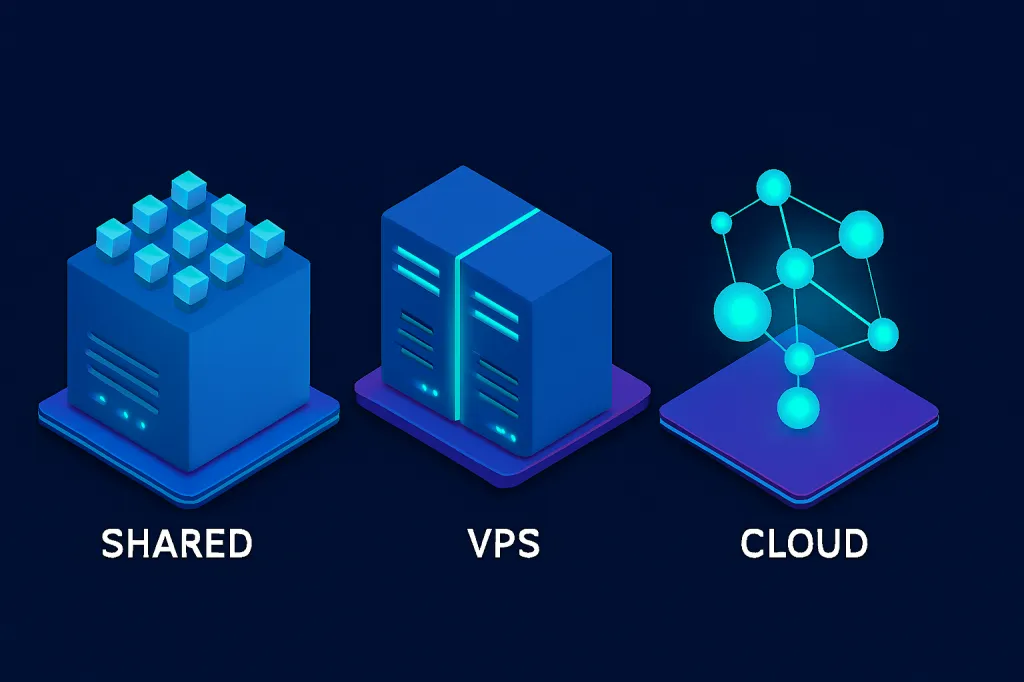Choosing the right web hosting is one of the most critical decisions you'll make for your website. Think of it as choosing the foundation for your house; the right choice ensures stability, performance, and room to grow, while the wrong one can lead to constant problems. For beginners, the terminology alone—Shared, VPS, Cloud—can be confusing.
This guide will demystify the three most popular types of web hosting. We'll break down what each one is, its pros and cons, and help you decide which one is the perfect fit for your website's needs, budget, and technical skill level.
1. Shared Hosting: The Apartment Building 🏢
Shared Hosting is the most popular and affordable type of hosting, making it the go-to choice for most new websites.
What it is: Imagine living in an apartment building. You have your own apartment (your website), but you share the building's main resources—like water, electricity, and the elevator—with all the other residents. In shared hosting, your website "lives" on a single server with hundreds or even thousands of other websites, sharing resources like CPU, RAM, and disk space.
Pros:
- Extremely Affordable: It's the cheapest way to get your website online.
- Beginner-Friendly: The hosting provider manages all the technical aspects of the server, including maintenance, security updates, and administration. You get an easy-to-use control panel (like cPanel) to manage your site.
- No Technical Knowledge Required: You can focus entirely on building your website without worrying about server management.
Cons:
- Limited Resources: Since you're sharing, a sudden traffic spike on another website on the server (a "noisy neighbor") can slow down your site.
- Less Secure: While providers work hard to isolate accounts, a vulnerability on one site could potentially affect others on the same server.
- No Root Access: You have limited control over the server environment and cannot install custom software.
Best for: New websites, personal blogs, portfolios, small business websites with low to moderate traffic.
2. VPS Hosting: The Townhouse 🏘️
VPS (Virtual Private Server) Hosting is the logical next step up from Shared Hosting when your website starts to grow.
What it is: This is like owning a townhouse. You still share the same plot of land (the physical server) with others, but your house is completely separate with its own walls and dedicated resources. A physical server is partitioned into several "virtual" servers, and each VPS account gets a guaranteed slice of the server's CPU, RAM, and storage that is not shared with anyone else.
Pros:
- Guaranteed Resources: The "noisy neighbor" effect is gone. Your site's performance won't be affected by others.
- Greater Control & Flexibility: You get "root access," which means you can configure the server environment and install any software you need.
- Improved Security: Your virtual server is isolated from others, creating a more secure environment.
- Scalable: You can easily upgrade your resources (RAM, CPU) as your website traffic grows.
Cons:
- More Expensive: Costs are significantly higher than shared hosting.
- Requires Technical Knowledge: With "Unmanaged" VPS, you are responsible for all server maintenance, security, and updates. However, most providers also offer "Managed" VPS plans where they handle this for you, but at a higher cost.
Best for: Websites that have outgrown shared hosting, growing online stores, developers who need a custom server setup, and businesses with medium to high traffic.
3. Cloud Hosting: The High-Tech, Scalable Network ☁️
Cloud Hosting is the modern, flexible powerhouse of the hosting world, offering superior reliability and scalability.
What it is: Instead of relying on a single server, your website's data is hosted on a cluster of interconnected servers (the "cloud"). If one server fails or is overloaded, another one instantly picks up the slack, ensuring your website stays online and runs fast. It's like a building made of intelligent, self-healing blocks.
Pros:
- Exceptional Uptime & Reliability: The distributed nature of the cloud means there is no single point of failure.
- Ultimate Scalability: Resources can be scaled up or down instantly to handle sudden traffic spikes. You often only pay for the resources you actually use.
- Peak Performance: With a vast network of servers, resources are allocated dynamically to ensure your site is always running at optimal speed.
Cons:
- Complex Pricing: Pay-as-you-go models can be unpredictable and may become very expensive if you experience a large, unexpected traffic surge.
- Can Be Technically Complex: While many providers offer user-friendly interfaces, managing a true cloud environment can be more complex than a traditional VPS.
Best for: High-traffic websites, large e-commerce stores, applications requiring 100% uptime, and sites with unpredictable, spiky traffic patterns.
Quick Comparison Table
| Feature | Shared Hosting | VPS Hosting | Cloud Hosting |
|---|---|---|---|
| Analogy | Apartment | Townhouse | Interconnected Network |
| Cost | Low | Medium | Medium to High |
| Performance | Basic | Good to Excellent | Excellent |
| Control | Low | High (Root Access) | High |
| Best For | Beginners, Low Traffic | Growing Sites, E-commerce | High Traffic, Scalability |
Conclusion
There is no single "best" type of web hosting—only the best one for you. For most people just starting, Shared Hosting is the perfect, cost-effective choice. As your site grows in traffic and complexity, you can then plan a seamless migration to a VPS. If you're running a large-scale application or a business where every second of uptime counts, Cloud Hosting offers the ultimate in reliability and performance.
Start with what you need now, but always keep an eye on your growth so you can upgrade when the time is right. Good luck! 👍





